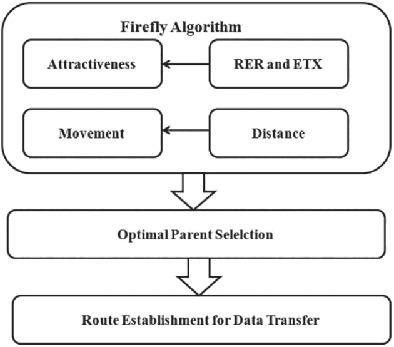当前位置:
X-MOL 学术
›
Trans. Emerg. Telecommun. Technol.
›
论文详情
Our official English website, www.x-mol.net, welcomes your
feedback! (Note: you will need to create a separate account there.)
Energy efficient optimal parent selection based routing protocol for Internet of Things using firefly optimization algorithm
Transactions on Emerging Telecommunications Technologies ( IF 2.5 ) Pub Date : 2020-12-03 , DOI: 10.1002/ett.4171 Sankar Sennan 1 , Ramasubbareddy Somula 2 , Ashish K. Luhach 3 , Ganesh Gopal Deverajan 4 , Waleed Alnumay 5 , N. Z. Jhanjhi 6 , Uttam Ghosh 7 , Pradip Sharma 8
Transactions on Emerging Telecommunications Technologies ( IF 2.5 ) Pub Date : 2020-12-03 , DOI: 10.1002/ett.4171 Sankar Sennan 1 , Ramasubbareddy Somula 2 , Ashish K. Luhach 3 , Ganesh Gopal Deverajan 4 , Waleed Alnumay 5 , N. Z. Jhanjhi 6 , Uttam Ghosh 7 , Pradip Sharma 8
Affiliation

|
Energy conservation is a major challenge in the Internet of Things (IoT) as the number of resource-constrained devices is connected to the network. Routing plays a vital role in IoT to extend the lifespan of the network. Routing protocol for low-power and lossy networks (RPL) is a standard routing protocol in IoT. The parent selection is a crucial role in the routing process to exchange the data. In RPL, the researchers have introduced a single metric, composite metric, and multiobjective optimization algorithm for parent selection. However, the improper parent selection causes the packet losses, congestion among the network nodes, depletes more energy, and increases the convergence time. To overcome these issues, this article proposes energy efficient optimal parent selection in RPL (EEOPS-RPL) using firefly optimization algorithm to extend the lifespan of the IoT network. In EEOPS-RPL, each node in the network is considered to be firefly and also calculates the current location of firefly, attraction of the fireflies, random function, velocity, and the global best values in the network. Residual energy and expected transmission count are attractiveness parameters and distance is a movement parameter to choose the optimum parent in the destination-oriented directed acyclic graph for data transmission. The simulation is conducted using COOJA. The EEOPS-RPL provides better performance in comparison to the efficient parent selection for RPL (EPC-RPL) and the E-RPL. The EEOPS-RPL improves the packet transmission ratio and lifespan of the network by 2% to 5%, and 5% to 10%, respectively, compared with EPC-RPL and E-RPL.
中文翻译:

使用萤火虫优化算法的基于节能最优父选择的物联网路由协议
由于连接到网络的资源受限设备数量众多,因此节能是物联网 (IoT) 中的一项重大挑战。路由在物联网中起着至关重要的作用,可以延长网络的使用寿命。低功耗有损网络路由协议 (RPL) 是物联网中的标准路由协议。父选择是路由过程中交换数据的关键角色。在 RPL 中,研究人员为父选择引入了单度量、复合度量和多目标优化算法。但是,不正确的父节点选择会导致丢包、网络节点拥塞、消耗更多能量并增加收敛时间。为了克服这些问题,本文提出了使用萤火虫优化算法的 RPL (EEOPS-RPL) 中的节能最优父选择,以延长物联网网络的寿命。在 EEOPS-RPL 中,网络中的每个节点都被认为是萤火虫,并计算萤火虫的当前位置、萤火虫的吸引力、随机函数、速度和网络中的全局最佳值。剩余能量和预期传输次数是吸引力参数,距离是在面向目的地的有向无环图中选择最优父节点进行数据传输的运动参数。使用 COOJA 进行模拟。与 RPL (EPC-RPL) 和 E-RPL 的有效父选择相比,EEOPS-RPL 提供了更好的性能。EEOPS-RPL 将网络的数据包传输率和寿命提高 2% 到 5%,
更新日期:2020-12-03
中文翻译:

使用萤火虫优化算法的基于节能最优父选择的物联网路由协议
由于连接到网络的资源受限设备数量众多,因此节能是物联网 (IoT) 中的一项重大挑战。路由在物联网中起着至关重要的作用,可以延长网络的使用寿命。低功耗有损网络路由协议 (RPL) 是物联网中的标准路由协议。父选择是路由过程中交换数据的关键角色。在 RPL 中,研究人员为父选择引入了单度量、复合度量和多目标优化算法。但是,不正确的父节点选择会导致丢包、网络节点拥塞、消耗更多能量并增加收敛时间。为了克服这些问题,本文提出了使用萤火虫优化算法的 RPL (EEOPS-RPL) 中的节能最优父选择,以延长物联网网络的寿命。在 EEOPS-RPL 中,网络中的每个节点都被认为是萤火虫,并计算萤火虫的当前位置、萤火虫的吸引力、随机函数、速度和网络中的全局最佳值。剩余能量和预期传输次数是吸引力参数,距离是在面向目的地的有向无环图中选择最优父节点进行数据传输的运动参数。使用 COOJA 进行模拟。与 RPL (EPC-RPL) 和 E-RPL 的有效父选择相比,EEOPS-RPL 提供了更好的性能。EEOPS-RPL 将网络的数据包传输率和寿命提高 2% 到 5%,











































 京公网安备 11010802027423号
京公网安备 11010802027423号